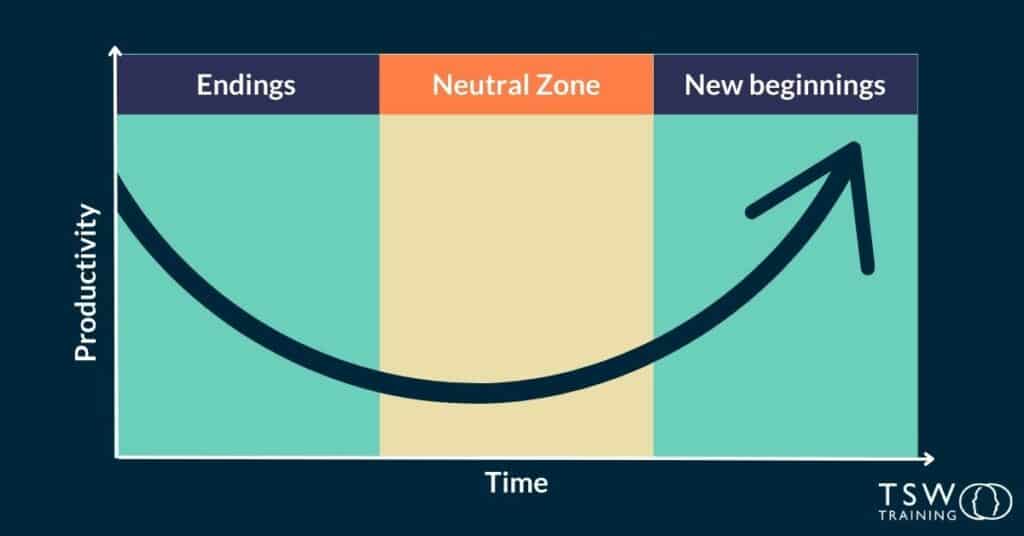Bridges Transitional Model According to Greek philosopher Heraclitus, “change is the only constant in life”. And yet, in a world which never stays still, change can be an unsettling and sometimes disruptive influence.
This is why Bridges’ transitional model is a useful tool to employ in the workplace, which is a framework to help guide workers through change. It’s based on the idea that – in contrast to change, which happens to us – transition is a psychological process which happens within us, allowing us to adapt to the new reality.
Here we’ll look at how you can apply Bridges’ transitional model in the workplace, ensuring that periods of adjustment cause as little disruption as possible. Your staff might even learn to embrace change as a positive!
⏰Key points:
- While change is something which happens to people, often not through their own choice, transition is the internal process of learning to adapt. Transition is likely to be a slower process, and there are several ways you can support your team with this.
- The three stages of change involve the ending of the current way of doing things; a neutral zone of flux before the new way of doing things beds in; and new beginnings, which may be accompanied by a renewed sense of motivation and purpose.
- Throughout the process, it’s important to clearly communicate the reasons and goals driving the change; provide bespoke support for members of your organisation as they go through the transition; and – as always – lead by example.
A brief history of Bridges’ transitional model
Bridges’ transitional model was developed by William Bridges, an American author, speaker and consultant who specialised in the area of transition management. Bridges first introduced his model in his 1991 book ‘Managing Transitions: Making the Most of Change’. Nowadays, this is regarded as a seminal work in the field of change management.
Bridges’ model was inspired by his observations of how individuals and organisations navigate change. He noticed that many struggled with change because they focused on the external factors, such as new technologies or processes. However, this was often at the expense of addressing the internal transitions – such as changes in attitudes, values and behaviours.
Bridges believed that successful change management required a focus on the internal transitions, which he defined as a psychological process that individuals – and in some senses organisations – go through as they adapt to change.
What are the three stages of transition?
The model involves three distinct stages: endings, a neutral zone and new beginnings. Each stage presents its unique challenges and opportunities, and understanding these can help workers navigate change more effectively.
Endings (AKA ending, losing and letting go)
The first stage of Bridges’ transitional model is – paradoxically – endings. This stage involves letting go of the old ways and preparing for the change.
Endings can be difficult, especially if workers are attached to the old ways of doing things, or feel uncertain about the future.
Some workers may resist change – feeling anxious, frustrated, or even angry.
💡As a leader, it’s important to acknowledge these feelings and help workers cope with them💡
Here are some strategies to guide workers through the endings stage:
- Provide clarity: Communicate clearly and honestly about why the change is necessary, what it entails and its benefits. Workers need to understand the reasons behind the change and what it means for them.
- Acknowledge feelings: Be empathetic by acknowledging and validating workers’ feelings about the change. Listen to their concerns, and put yourself in their shoes regarding the fears and anxieties they express. This can help workers feel heard and valued, and reduce resistance to change.
- Celebrate the past: Recognise and celebrate the past accomplishments and contributions of workers. This can also help them feel valued and appreciated, and provide closure to the old ways of doing things.
Neutral zone
The second stage of the transitional model is what Bridges called the ‘neutral zone’. This stage involves a period of confusion and uncertainty, as workers adjust to the new reality.
It can be a challenging time, as workers navigate the unknown and try to find their footing. It’s typical for staff to feel impatient and sceptical during this period, and morale is likely to dip.
💡As a leader, it’s essential to provide support and guidance during this stage💡
Here are some strategies to guide workers through the neutral zone:
- Provide support: Make support and resources available to help workers adapt to the new situation. This may include training, coaching, mentoring or even emotional support. Workers are likely to need extra support during this time, and providing it can help them feel more confident and capable.
- Encourage experimentation: Take a positive view of workers experimenting with new ways of doing things. This can help them discover what works and what doesn’t, and build their confidence in the new situation. Encourage them to take calculated risks and learn from their mistakes.
- Foster collaboration: Encourage collaboration and teamwork. Workers may need to work together to solve problems and develop new solutions, so it’s best to encourage them to share ideas and expertise, and learn from each other.
New beginnings
The third stage of Bridges’ transitional model is new beginnings. This stage involves a renewed sense of energy and purpose, with workers embracing the change and moving forward.
It can be an exciting time, as workers see the benefits of the adjustment and start to reap the rewards.
💡As a leader, it’s important to encourage and support workers during this stage💡
Here are some strategies to guide workers through the new beginnings stage:
- Celebrate successes: Celebrate the successes and achievements of workers. This can help them feel motivated and energised, and reinforce the benefits of the change. Shine the spotlight on both individual and team successes.
- Provide ongoing support: Ongoing support and feedback will help workers continue to grow and develop. Encourage them to set goals and measure their progress. And be sure to provide opportunities for learning and development.
- Reinforce the change: Keep the change at front of mind, and ensure that workers continue to embrace it. This may involve communicating the benefits of the recent adjustment, providing ongoing training and support, and reinforcing the new ways of doing things.
Challenges you may face in applying Bridges’ transitional model
While this framework is useful for understanding how the process of change may affect people, it’s worth noting that the transition may not go as smoothly as the model suggests. Moreover, workers may experience the stages at different times, with some being more amenable to change than others. It’s important to be flexible and adaptable, and to provide customised support based on the unique needs and circumstances of each worker.
It’s key to communicate openly and transparently throughout the change process. Workers need to understand what’s happening, why it’s happening, and what’s expected of them. Communication should be clear, honest and timely. Leaders should also be open to feedback and concerns from workers, and address them promptly and appropriately.
⏰Key point: As always, it’s important to lead by example during times of change. Leaders should demonstrate the behaviours and attitudes that they want to see in workers, such as adaptability, resilience and a positive attitude. This can help inspire and motivate workers, and create a culture of willingness and readiness to change.
Bridges’ transitional model in summary
So, by applying Bridges’ transitional model, you’ll be laying a valuable framework for guiding workers through change. By understanding the three stages of transition, leaders can provide the necessary support and guidance to help workers navigate change effectively.
It’s important to communicate openly and transparently, provide ongoing support specifically catered to individual needs, and lead by example during times of change. With the right approach, workers can successfully adapt to change and thrive in the new reality.









